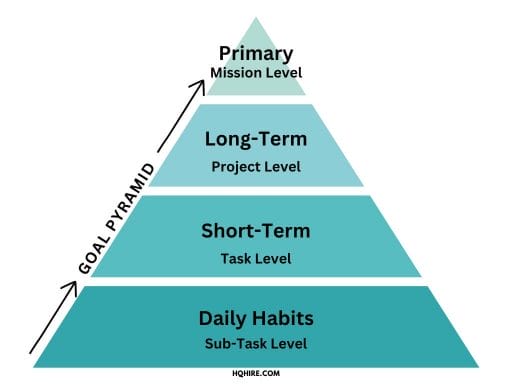Are you looking to level up your career and achieve your professional aspirations? If so, then it’s time to harness the power of the Goal Pyramid.
Exploring some of the best strategic goal-setting technique, this guide will bring you on a path to success, helping you bridge the gap between your dreams and reality.
Here we will look into the concept of the Goal Pyramid, and take you step by step walking you through the process of creating your own Goal Pyramid.
With some simple examples, we will show you how this Goal Pyramid can help you in reaching your goals.
KEY TAKEAWAY
- Goal Pyramid is a great way to set better goals, and using the Goal Pyramid technique together with SMART Goals can help you achieve your goals faster.
- For Goal Pyramid, you can do either top down approach or bottom up approach, depending on the questions you ask, either will be a good ways to set your goals.
- There are 4 levels of goals in a Goal Pyramid, from the bottom these are the sub-task level, to task level, to project level to the mission level which lies at the top of the pyramid.
What is a Goal Pyramid?
Imagine a roadmap that connects your life mission with your most important projects and daily tasks, that’s precisely what the Goal Pyramid looks like!
Goal Pyramid is a triangle with a large base at the bottom and ends up with a sharp peak at the top, representing the stages and progress of your goals towards your final true goal.
However, depending on the different questions you are going to ask, it can goes from the the top down approach as well.

This powerful structure empowers you to set clear and achievable goals, enhancing your motivation, progress, and overall satisfaction with each step forward.
Different Levels of a Goal Pyramid
Understanding the various levels of the Goal Pyramid is crucial to successful goal-setting. And with that we will look into the different levels of the Goal Pyramid.
Primary Goal Level or The Mission level
Your long-term goals for your main projects, encompassing happiness, contribution, and learning. This is the highest level and also the 1st level of your Goal Pyramid.
This is your ultimate career aspiration, such as reaching a specific position or starting your own business.
Ensure your primary goal is specific, measurable, attainable, relevant, and time-bound (SMART).
Long-Term Goals Level or Project level
The projects that align with your life mission, such as career, business, family, health, and spirituality. This is the 2nd highest level of your Goal Pyramid.
These are milestones that will lead you closer to your primary goal.
Set 2-3 long-term goals for each primary goal, outlining what needs to be accomplished within weeks or months.
Short-Term Goals Level or Task level
The actionable steps needed to make your projects successful. This is 3rd level of your Goal Pyramid.
These are specific tasks and actions that contribute to your long-term goals.
Break down each long-term goal into actionable steps that can be completed within days or weeks.
Daily Habits Level or Subtask level
Small, time-bound tasks required to accomplish the bigger ones. This is the 4th level and also the base of your Goal Pyramid, the foundation of your Goal Pyramid.
The foundation of your Goal Pyramid lies in your daily habits and routines.
Establish small, specific, and actionable habits that contribute to accomplishing your short-term goals.
How to Create a Goal Pyramid?
The Goal Pyramid technique revolves around asking two essential questions: HOW and WHY.
Asking HOW Using The Top-Down Approach
This approach involves breaking down your big goals into smaller, manageable tasks. Think of it like eating an elephant—one bite at a time! To do this:
- Identify your primary goal (e.g., achieving a leadership position).
- Ask yourself, “How can I achieve this goal?” to set long-term goals (e.g., skill development, networking).
- Continue asking “How?” for each long-term goal to arrive at specific short-term goals (e.g., attending workshops, updating your resume).
By doing this, you build a clear path to your primary goal.
Asking WHY Using The Bottom-Up Approach
This approach ensures your tasks are aligned with your ultimate goals. To apply this:
- Start with a specific task (e.g., attending workshops).
- Ask yourself, “Why am I doing this?” to connect it to a long-term goal (e.g., skill development).
- Keep asking “Why?” for each long-term goal to link them to your primary goal (e.g., achieving a leadership position).
This process weeds out irrelevant tasks and ensures your efforts contribute meaningfully to your aspirations.
Step By Step Guide to Create a Powerful Goal Pyramid
Now that you understand the essence of the Goal Pyramid, let’s take a look into the practical steps to create your own Goal Pyramid to help you reach your goals.
Step 1: Create a Comprehensive Goal List
Write down all your career goals in a list format. Categorize them into different areas of your life, such as Career, Financials, Family, Friends, Spirituality, and Health.
Step 2: Organize Goals into Categories
Take your list and categorize each goal under the respective life segment. This will help you visualize your overall aspirations.
Step 3: Order Goals According to Levels
This step involves arranging your goals in the form of a pyramid. You can either use a mind map or an indented task list to represent the hierarchy.
Step 4: Uncover the “WHY” of Each Goal
Ask yourself “Why?” for each goal to find its relevance to your primary goal. Goals without a strong enough “why” can be reevaluated.
Step 5: Uncover the “HOW” of Each Goal
Ask yourself “How?” for each goal to determine the actionable steps required to achieve it. This fills in the missing goals on the lower levels of the pyramid.
Goal Pyramid Examples
Let’s explore some real-life examples of Goal Pyramids in different career scenarios:
Advancing in a Corporate Career
- Primary Goal: Attaining a leadership position.
- Long-Term Goals: Skill development, networking, and mentorship.
- Short-Term Goals: Attend leadership workshops, build professional connections, seek mentor guidance.
- Daily Habits: Read leadership books daily, network on LinkedIn, practice public speaking.
Starting and Growing a Business
- Primary Goal: Launching a successful startup.
- Long-Term Goals: Market research, business plan development, team building.
- Short-Term Goals: Conduct market surveys, create a detailed business plan, hire key team members.
- Daily Habits: Research industry trends, work on business strategies, communicate with team members.
Transitioning to a New Career Path
- Primary Goal: Switching to a new industry.
- Long-Term Goals: Gaining relevant skills, networking in the desired field, updating the resume.
- Short-Term Goals: Enroll in online courses, attend industry events, customize the resume.
- Daily Habits: Spend time learning new skills, connect with professionals on social media, update the resume regularly.
Goal Pyramid For Goal Setting
The Goal Pyramid technique is a powerful and actionable tool that can revolutionize your approach to personal and professional goals, including career planning.

By aligning your goals with your ultimate aspirations, you’ll stay focused, motivated, and on track to achieve career success.
Remember, Rome wasn’t built in a day, each step you take towards your primary goal brings you closer to realizing your dreams.
So, grab a pen and paper, and start crafting your Goal Pyramid today. Unlock your full potential and soar towards a fulfilling and accomplished career!
Read Also:
- +21 Best Types of Goal Setting Techniques (Succeeding at Work)
- 22+ Goal Setting Statistics You Should Know in 2024 (Facts and Studies)
- Ultimate Guide to Hoshin Kanri (Policy Deployment) Strategic Planning (Step Guide)
- Management By Objectives (MBO) Goal Setting Model (Examples and Templates)
- OKR Framework: Ultimate Guide to Achieving Key Result & Goals (with Templates + Examples)
Join over 11,000+ achievers who are committed to achieving their career goals!






